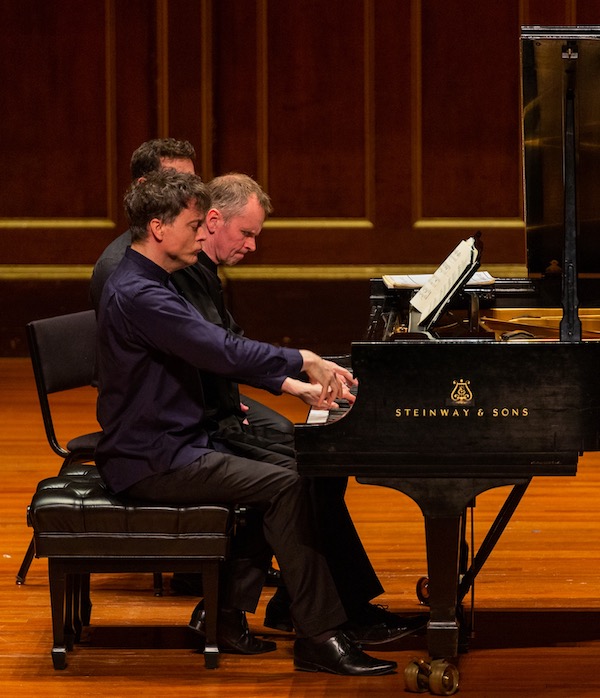A show of hands for pianists Osborne and Lewis at Jordan Hall

“Respect the pianoforte!” the pianist and composer Ferruccio Busoni wrote in 1907, adding, “It gives a single man command over something complete.”
In the hands of two expert performers, the piano becomes capable of even greater expressive power and textural depth, even in the gentlest of works. That was the effect conveyed at Jordan Hall on Friday night, when English pianist Paul Lewis and his Scottish counterpart Steven Osborne offered a four-hands recital as part of the Celebrity Series.
Osborne and Lewis continue to offer probing interpretations of the heftiest solo and concerto repertoire, ranging from Beethoven and Schubert to Grieg and Rachmaninoff. But in Friday’s program of suites by mostly French composers, they combined their powers for subtlety to explore the nuances of miniature forms.
Debussy’s Six épigraphes antiques fires the imagination with its musical imagery, and Osborne and Lewis performed the set with a watercolorist’s soft touch, crafting musical scenes of sensuous delight.
Seated on the right bench, Osborne rendered the opening calls of “Pour invoquer Pan” with a pastoral grace that carried over into a distant “Pour un tombeau sans nom,” where the pianists’ combined phrases coalesced in a wreath of sound. The passages of “Pour que la nuit soit propice” chimed like bells, while one got the vivid sense of a dancer’s swirling gestures when the duo teased out the flourishes of “Pour la danseuse aux crotales.”
The chugging rhythms and exotic chromaticism of “Pour L’Égyptienne” may be clichéd depictions of Arabic music today. Yet the duo found a spaciousness and detachment fitted to this music, their lines rising and falling like breath. “Pour remercier la pluie au matin,” which depicts rain in the morning, showcased the duo in shimmering figures that seemed to evaporate into silence.
In Ravel’s Mother Goose Suite, Osborne and Lewis played with a storyteller’s grace. The “Pavane de la Belle au bois dormant” was dreamily rendered, while the two shaped the soft chords of “Petit Poucet” searchingly, the music seeming to introduce a story from long ago.
The light filigree of “Laideronnette, Impératrice des pagodes” turned sprightly in the duo’s hands, and “Les entretiens de la Belle et de la Bête” involved them in gentle dialogue — Osborne’s waltzing figures capturing Belle’s charm, while Lewis’s dark left hand murmurings conveyed the beast’s questioning and resolve. Glistening harmonies captured the verdant beauties of “Le jardin féerique.”
Fauré’s Dolly Suite, written for the daughter of the composer’s lover, Emma Bardac, was just as tender. With Lewis playing the treble parts, the “Berceuse” took on a soft elegance. Equally expressive was “Jardin de Dolly,” where the pianists traded melodies with chamber-like sensitivity. “Kitty Waltz” took off in a sweeping lilt. So too did “Pas Espagnol,” a study in Spanish zest and intensity. The pianists unfolded the passages of “Mi-a-ou” congenially, their figures crisp even with Osborne applying light pedal.
Their performance of Debussy’s Petite Suite explored dazzling technical feats. The rollicking figures of “Ballet” took off in swift gestures, while the lines of the “Menuet” sounded with a courtly air. “Cortège” featured Lewis in additionally animated filigree, which Osborne supported with a supple but resonant bass. “En bateau” yielded gentle contrasts with wafting phrases and harmonies.
Consisting of three brief movements, Poulenc’s Sonata for Piano Four Hands is a suite in all but name, and its bristly rhythms and clamorous dissonances provided the materials for a thoroughly exciting spectacle. The “Prelude,” with its biting harmonies, came off with percussive flourish. “Rustique” summoned orchestral grandeur as Osborne unspooled gentle trills over Lewis’s tender melody in the middle voices. Blazing runs — handled dexterously by both performers — transformed “Final” into a truly virtuosic showpiece.
Osborne and Lewis rendered Stravinsky’s Trois pièces faciles with precision, clarity and good humor, from the pomp of the “March” to the crafty sweep of the “Waltz” to the final movement “Polka” in all its oompah hilarity. Their encore, the “Dumka” from Dvořák’s Slavonic Dances, Op. 72, added a lyrical finishing touch to a program that Busoni himself would have applauded.
The Celebrity Series will host violinist Joshua Bell and the orchestra of the Academy of St. Martin in the Fields in music by Mozart, Paganini, and Brahms 3 p.m. Sunday at Symphony Hall. celebrityseries.org; 617- 482-6661
Posted in Performances




